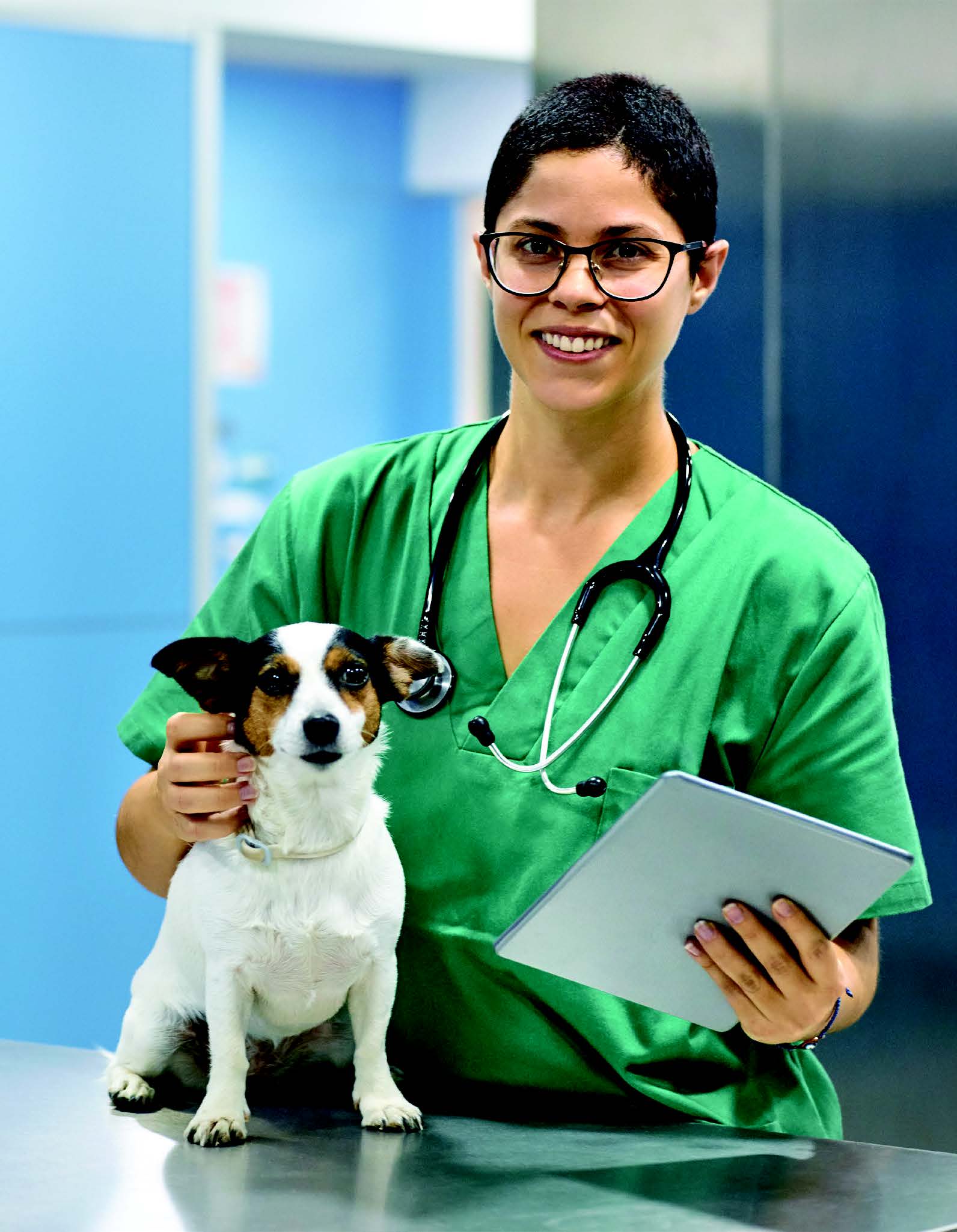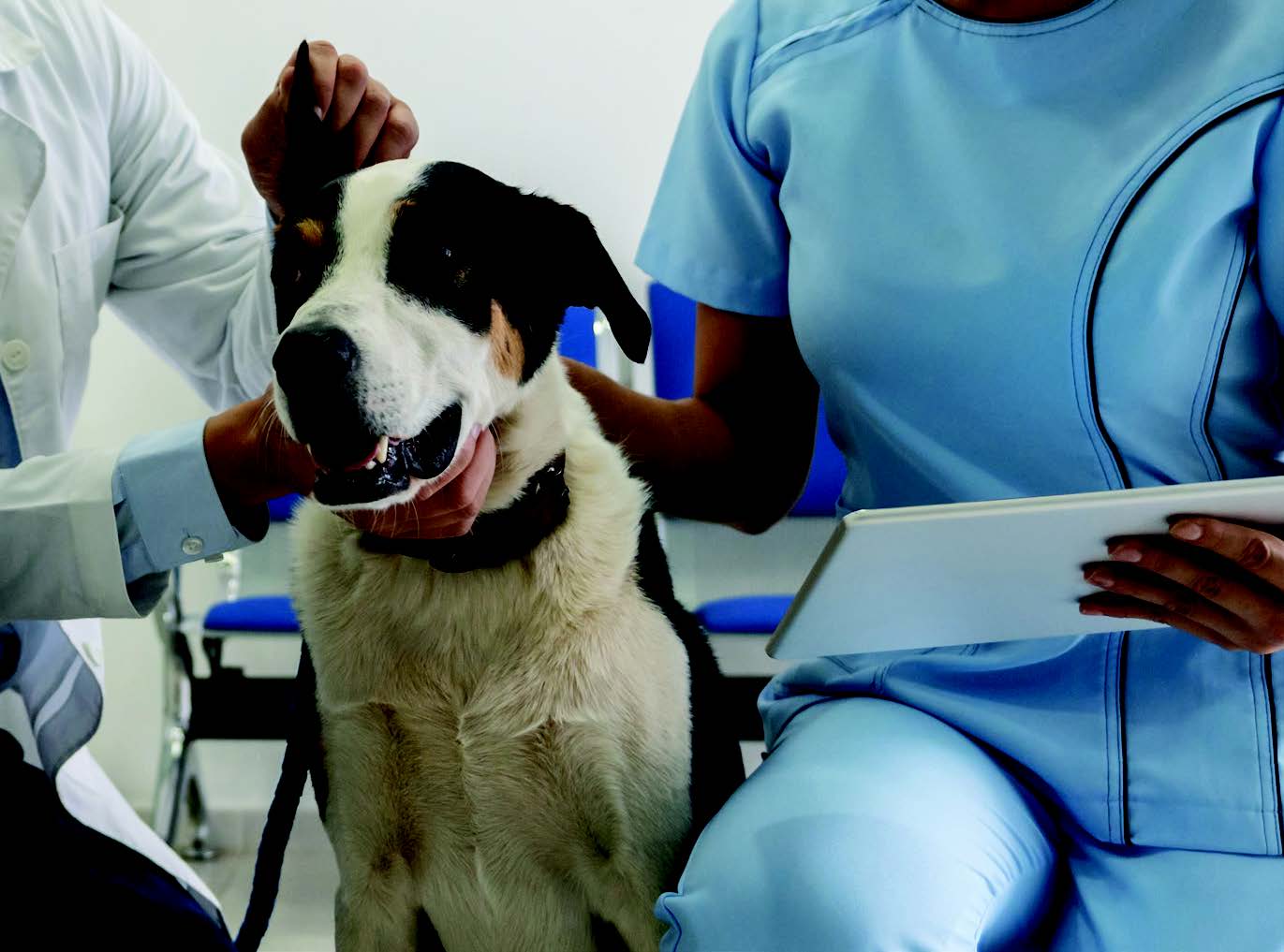Techs and Telehealth
Using Technicians as a Way to Ease into Telehealth
by Tony McReynolds
Nobody has to tell you how crazy it’s been.
Veterinarians and practice staff, overwhelmed by an unexpected flood of pandemic pet adoptions, have spent the last year struggling to juggle new safety protocols with implementing curbside service while trying to field the seemingly nonstop onslaught of phone calls, texts, and emails from desperate pet owners looking for appointments.
“You can have an audio/video live feed, and the tech can remind the client of what they learned while in the hospital and watch them do it step by step while virtually holding their hand.”
—LORI M. TELLER, DVM, DABVP, TEXAS A&M UNIVERSITY
As many practices discovered during the early days of the pandemic, implementing elements of telehealth could help.
But for practices already overwhelmed with trying to keep up with exigencies of keeping their doors open during the pandemic, launching full tilt into telehealth was one too many things on the plate. But easing into telehealth might be simpler than you think.
Trust in Your Techs
That’s the advice of telehealth expert Lori M. Teller, DVM, DABVP, an associate professor of telehealth in the College of Veterinary Medicine and Biomedical Sciences, Texas A&M University, and vice chair of the American Veterinary Medical Association (AVMA) board of directors.
Teller says veterinary technicians can be the champions of telemedicine for the practice: “They can educate clients about what telemedicine is and what can be done with it,” she says. They can also help clients decide if their pet really needs an in-practice visit by facilitating a telemedicine visit first.
 “Almost anything you can do during [an in-office] tech appointment, especially an educational tech appointment, you can do in a virtual visit.”
“Almost anything you can do during [an in-office] tech appointment, especially an educational tech appointment, you can do in a virtual visit.”
Teller says that though virtual appointments obviously don’t include collecting blood or tissue samples, they could include taking histories, going over home care instructions, and basic triage.
“Let’s say you as the doctor have recently diagnosed a patient with diabetes or a cat with chronic kidney disease,” Teller says. “And you’ve explained to the owner during the office visit that you want them to administer insulin injections and how to do it.”
But all too often, Teller says, they’ll have forgotten everything you’ve told them as soon as they get home, “and now they’re terrified they’re going to hurt their pet.”
That’s where telemedicine and the tech come in, Teller says.
“You can set up an appointment with the client via telemedicine, and the technician is right there. You can have an audio/video live feed, and the tech can remind the client of what they learned while in the hospital and watch them do it step by step while virtually holding their hand.”
Teller says that can really boost the client’s confidence in their ability to provide whatever home care they need to be doing. “And that’s true whether they’re administering fluids, giving allergy injections, or taking readings with a continuous glucose monitor.”
Perhaps more importantly, that virtual visit with your tech really bonds the client to your practice—and staff. “I think we all know that clients come to see the veterinarian, but it’s really the technicians who seal the deal,” Teller says.
This isn’t surprising since techs are the ones who spend the most time with the client, taking histories, having conversations, and prepping both the client and patient for their visit with the veterinarian.
|
|
AAHA Telehealth Guidelines |
|---|---|
| Did you know that AAHA has guidelines for telehealth? Check out the 2021 AAHA/ AVMA Telehealth Guidelines for Small-Animal Practice on the web at aaha.org/telehealth | |
Teller says that if the techs are doing the same things virtually as they’d be doing in person, then telemedicine can be a tremendous way for the technicians to take some of the burden off the veterinarians: “Just knowing that someone’s there to hold your hand, even if it’s in a virtual manner, can inspire great confidence.”
Shlomo Freiman, DVM, co-owner of AAHA-accredited Animal Hospital of Factoria in Factoria, Washington, is a passionate proponent of veterinary telemedicine, and he says using techs to help implement it is key.
Freiman got interested in telemedicine a few years ago when he was trying to address the impact the internet was having on how veterinarians practice medicine.
“As a source of information,” he says, “the internet was increasingly coming between me and my clients in an exceedingly significant way.” Dr. Google was just one example.
But when Freiman discovered he could use the internet to his advantage, enabling him to communicate better with his clients, increase efficiency, and improve the workflow in the clinic, he cofounded Petriage, a pet health technology company that provides telehealth services for veterinarians and their clients, in 2015.
Freiman says that while a lot of people associate telemedicine with video chat, he believes the real strength lies in the way it can combine synchronous and asynchronous communication, especially through text.
“It’s really a game changer,” Freiman says.When Freiman talks about text, he doesn’t mean SMS messages sent by phone, although that can be a part of it. He’s talking about a written record where all communications between veterinarians, CSRs, techs, and clients—whether by phone, email, text, or video—are recorded in a central online location that all staff can access.
Freiman calls it a combination of synchronous and asynchronous communication.Freiman says that having everything available in a single location, easily accessible by techs on smartphone or tablet, eliminates the potential confusion of multiple phone calls, garbled verbal messages, and multicolored trails of sticky notes: “When it’s text-based, I can see what the client said, I can see what the tech said, and I can jump in and add my own input.”
“Techs can message me and say ‘Hey, can you please look at this case and let us know what you want us to do?”
—SHLOMO FREIMAN, DVM
Freiman says that kind of transparency means far less stress on everyone.“Techs can message me [and] say ‘Hey, can you please look at this case and let us know what you want us to do? Or do you want to talk directly to client?’”Or the tech can message the client and relay a question from the veterinarian, Freiman says: “When’s the last time your dog vomited, for example.”
If the client is on their phone, they can answer right away and you can move to the next step. If they don’t answer right away, you know they’ll get an alert that you’ve sent a message and at some point, they’ll respond. Meanwhile, you can move on to another patient where all the information is in and you’re ready to proceed.
And everything goes into the written record, with techs updating the information as it comes in. Which, Freiman says, really beats waiting on hold for an answer.Adding ValueJenica Veley, RVT, has spent her share of time on hold.Veley, founder of VirtualVetTechs, an online veterinary support service, literally grew up answering phones in a veterinary practice—her mom was a vet in Ontario, Canada, and Veley started working at her practice by answering phones, scheduling appointments, and just generally learning everything there was to know about how to run a veterinary practice.
Including how key technicians are to the process.
Veley left her job at an Ontario practice to found VirtualVetTechs in mid-2020, right as the pandemic was ramping up, and she found a ready market for her services. She clearly sees the value of telemedicine from a tech’s point of view, having been one herself.
The biggest value is how much time techs can save the veterinarian. As an example, Veley imagines a pet owner who calls her, worried about a bump that appears on the surgical site after a recent spay. As an experienced tech, Veley says she knows that if the client takes a photo of the area and sends it her, she’ll likely know by looking at the photo if the bump is something serious that needs to be seen immediately or more likely just a suture reaction that can wait a couple of days.And Teller agrees that frequently, technicians are already doing that initial triage.
But Teller is careful to point out that even experienced techs shouldn’t look at a photograph some client sent in because they’re worried about a rash and say, “That looks fine, you don’t have to bring him in.”
Teller says it may look fine, and may in fact be fine, but the tech can’t legally make that call: “That would be making a diagnosis, which is something the veterinarian would have to do.” By law, technicians can’t make a diagnosis or prescribe a treatment plan.
Either way, the tech would run it by a veterinarian at the practice, who makes the actual call. Then they can relay the information to the client, and say, “[the vet says] it looks fine—let’s see how things go, and send a photo if you see any changes; we’ll review in a day or two.” Or, if the vet sees something worrisome, “[the tech] can tell the client to bring the pet in right now.”
By using techs to help triage cases virtually, Veley says “you won’t have people showing up with a pet with a torn toenail that stopped bleeding an hour ago.”
Karen Bradley, DVM, owner of AAHA-accredited Onion River Animal Hospital in Berlin, Vermont, says her practice has had great success using techs to ease into telemedicine.“We approached it from the concept of connected care,” Bradley says. She’d been looking at telemedicine platforms before the pandemic and just happened to sign with one in December of 2019. While she found it a tremendous help during COVID-19, she thinks it’s something the profession has needed for a long time: “Having a way to stay connected with clients while their pets are in the clinic is very valuable.”
The Client ConnectionBradley uses telemedicine to stay connected with clients who drop off their pet for a surgery or any kind of dental or inpatient procedure. The particular platform Bradley uses has a portal that allows owners to be in continuous remote contact with the practice if they want to be.“
Our technicians have tablets, and they can take pictures of the pet in recovery or send the owner a picture of the bad tooth.” The portal allows techs to exchange texts with clients and send them updates the whole time. Bradley says clients love it. “They feel more up-to-the-minute connected.”Bradley adds that virtual connection can eliminate the fear some clients have when staff take their pet into what she calls “the dreaded back” for a procedure.
In at least one respect, Bradley says, curbside wasn’t new to clients with the pandemic. They’ve always dropped their pets off for procedures and picked them up again at the end of the day. “But with telemedicine, they can drop off their pet and leave without feeling disconnected or like they don’t know what’s going on.”
An added bonus: Bradley says if the veterinarian notices something while the patient is in the hospital, the techs can message the client about it.
“They’re able to say, ‘Hey, we noticed a new lump since the last time you were in’ and send them a picture of it asking, ‘Have you noticed this?’ The techs can get real-time answers from the client much more efficiently than if we had to pick up the phone, call them, leave a message, and wait.”
Her younger techs especially have taken to telemedicine; as Bradley notes: “It’s a way they’re used to communicating anyway. They text and send pictures all the time. They spend a lot of time on social media. And so do more and more of our clients.” Bradley says telemedicine makes sense for both clients and staff.
“Communication is our strong suit, and [telemedicine] has really made it efficient for them.”Bradley says it’s very painless for the client, too, especially the tech-savvy ones. “They feel very connected to the process and like they have their own personal nurse on their pet’s case.”
The more that practices make use of the various aspects of telehealth, the easier it gets.
Her techs sign each message with their name to personalize it.
“When the client gets a photo of the actual technician who’s taking care of their pet, signed with their name, and a message like, ‘Oh my gosh, Charlie is so cute, when he woke up he was doing such and such,’ plus personal details, that shows that the tech really does have a history with the pet.”
Bradley says that at a time when owners usually feel anxious and isolated from their pet, a personalized message can make a huge difference. “Clients really love that and feel connected.”
Synergies
Freiman says a combination of techs and telehealth provides for better outcomes and means less stress on the staff: “There’s much less friction in the whole workflow.” Plus, it allows the veterinarian to see more patients, “especially these days when it can take weeks to schedule an in-hospital visit.”
Freiman adds that while there’s no substitute for a hands-on physical exam, there’s a clear need for telehealth.
“It’s [becoming] an essential part of what we do.” And once you add elements of telehealth to your practice, you’re actually expanding your business model—and that grows your practice.
“I see telemedicine working hand in hand with the brick-and-mortar practice,” Freiman says. He uses the term “brick and click” to describe the hybrid model of hands-on and virtual. “Because that’s the new reality. Our clients want to be able to communicate with us easily and effectively.” As far as services go, Freiman adds, “I’m going to provide them with whatever’s appropriate in the brick-and-mortar [model] and whatever’s appropriate virtually.
”While a lot of practices report that they’ve been relying on some aspects of telemedicine to help ease the burden during the pandemic, Lori Teller says there hasn’t been any substantive research done yet to prove that telemedicine has made a definite difference to practices. So it’s too soon to say whether or not the pandemic has ushered in a new age of veterinary medicine.
“There was a tremendous surge of interest [in telehealth]. Then curbside became a thing and that interest leveled off.” Teller believes that veterinary practices are using telemedicine to a greater extent than they were before the pandemic, but not at the same levels as we saw early in the pandemic.
She also doesn’t think we’ll see a huge uptick in the number of practices adopting telemedicine as result of the pandemic. But she does think the pandemic gave it a boost. “I think people are learning how they can better utilize it in their day-today workflows.”
The more that practices make use of the various aspects of telehealth, the easier it gets. “It just becomes a part of everything that you do. I do think that veterinarians who are willing to try it will get better at monetizing it.”
If practices still shy away from telehealth, lack of emotional bandwidth is likely part of the reason. “Veterinarians and their staff have been incredibly busy during the pandemic,” Teller notes. Most are still feeling a little shellshocked, others as though they’re just treading water. A few are trying to step back and figure out how telemedicine can best be incorporated into their workflows.
The upshot is, thinking about how to adopt telehealth isn’t top of mind for most veterinarians right now. But it also doesn’t have to be, especially if practices trust their technicians to help them ease into it.
Teller says that once things return closer to normal and in-clinic appointments replace curbside service, “it’ll actually be easier to take a deeper dive into what those workflows look like and find the balance between the telemedicine visits and the brick-and-mortar visits.”
Jenica Veley’s mom passed way in 2010, but Veley calls her a “visionary” who would have been quick to adopt telemedicine. “She believed that care should be given where people were ready to receive it,” Veley says. And for Veley, that describes telemedicine perfectly. “If somebody is reaching out to you over the phone, they’re ready to receive care right there.”
 |
Tony McReynolds is AAHA's NEWStat editor, and host of the AAHA podcast, Central Line. |
Photo credits: Morsa Images/E+ via Getty Images, Vasyl Dolmatov/iStock via Getty Images Plus, andresr/E+ via Getty Images.



